Great Hornbills are a sight to behold. With their striking appearance, these magnificent birds have been capturing the attention of birdwatchers and nature enthusiasts alike.
It’s not just their looks that make them stand out, though; they also play an essential role in maintaining our planet’s biodiversity.
Originating from Asia’s tropical and subtropical forests, Great Hornbills are known for their large size and brightly colored beaks. But don’t let their intimidating presence fool you – these creatures are gentle giants.
Their diet primarily consists of fruit, which helps scatter seeds across vast areas, aiding forest regeneration.
While I marvel at the beauty and uniqueness of the Great Hornbill, it’s hard to ignore the challenges facing this species. Despite being protected under wildlife conservation laws in many countries, habitat loss and hunting still threaten its survival.
This has led to a decline in their population, making every effort to conserve this iconic bird crucially important.
Overview of the Great Hornbill
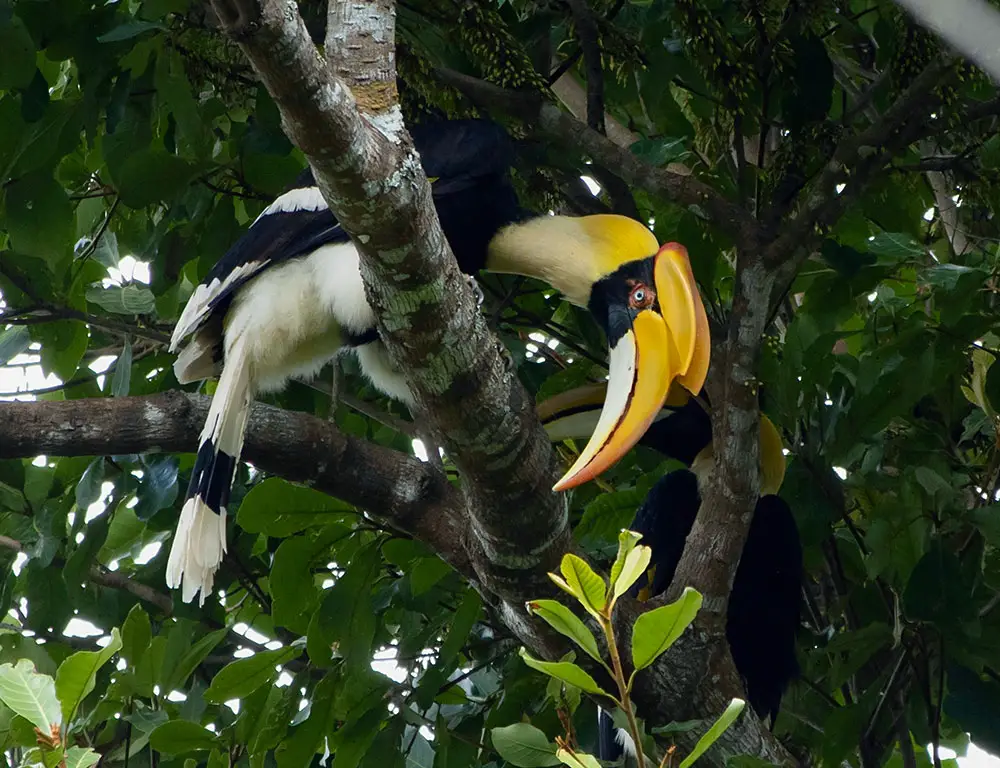
The Great Hornbill, a majestic bird found in the rainforests and deciduous forests of Southeast Asia and the Indian Subcontinent, possesses several unique and captivating characteristics:
Impressive Size
Male Great Hornbills typically measure between 39 and 47 inches, while females range from 36 to 39 inches. Their substantial size makes them stand out in their natural habitat.
Vibrant Plumage and Distinctive Casque
These birds exhibit vibrant plumage, with flashes of yellow and black feathers contrasting beautifully against lush green foliage.
Their most distinctive feature is the casque, a hollow structure on top of their beak, which serves multiple purposes and gives them a unique appearance akin to wearing extravagant headgear.
Ecological Role
Great Hornbills play a crucial role in maintaining forest ecosystems. They contribute to seed dispersal by feeding on fruits and dispersing seeds through their droppings, aiding in forest regeneration.
Additionally, they help control the population of small animals, including rodents, acting as natural predators and contributing to ecosystem balance.
Ecosystem Balance
The presence of Great Hornbills contributes to biodiversity and ecosystem balance. By dispersing seeds and controlling prey populations, they support the health and resilience of forest ecosystems.
Physical Characteristics of the Great Hornbill
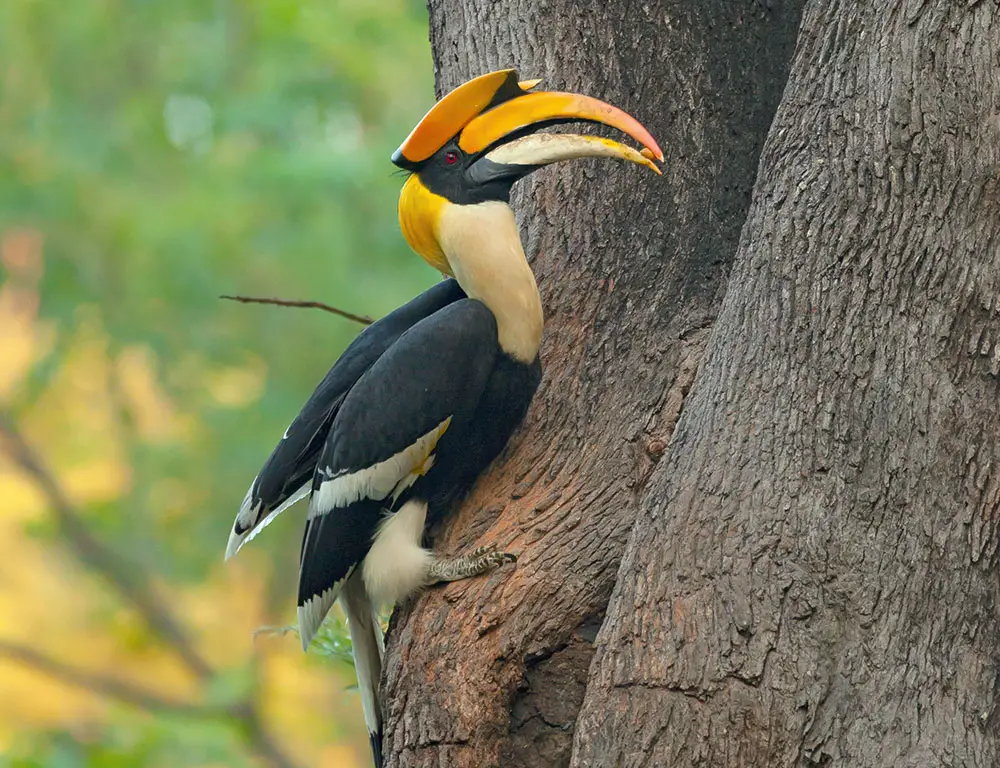
The Great Hornbill’s remarkable physical characteristics make it stand out in the avian world.
Size
These birds are notably large, with males reaching up to 51 inches (130 cm) in length and weighing 6.6 to 8.8 lbs (3 to 4 kg) on average.
Females are slightly smaller, measuring around 44 inches (110 cm) in length and weighing between 4.4 to 5.3 lbs (2 to 2.4 kg).
Casque
One of the Great Hornbill’s most distinctive features is the large casque on top of its beak. This hollow structure, made of keratin, serves several functions, including amplifying calls, resonating during mating rituals, and protecting territorial disputes.
Plumage
The plumage of the Great Hornbill is lovely. They have bright yellow and black feathers that create a striking contrast, with their long white tails adorned with broad black stripes, adding to their aesthetic appeal.
Eye Color
The eye color of Great Hornbills differs by gender. Males have red irises, while females showcase white irises encircled by blue rings, making their eyes particularly captivating.
Habitat and Distribution of the Great Hornbill
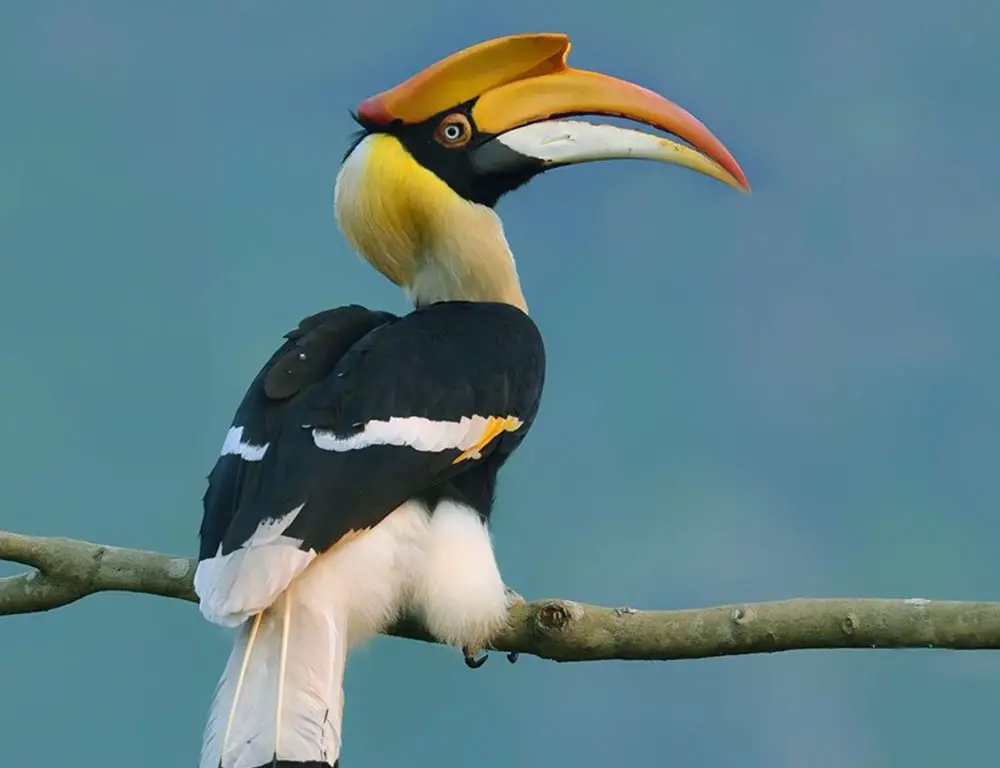
The Great Hornbill’s charming presence inhabits diverse habitats across the Indian subcontinent, Southeast Asia, and Indonesia.
Here are some key points about its habitat and distribution:
Preferred Habitat
Great Hornbills are typically found in forests, particularly tall trees and abundant fruit-bearing plants. They prefer dense woodlands where they can roost in tree holes high above the ground.
Geographical Range
Their distribution extends across various countries, including parts of India, Nepal, Myanmar (Burma), Thailand, Cambodia, Vietnam, and several Indonesian islands such as Sumatra and Borneo.
Habitat Conditions
Each region within its range provides unique conditions catering to different lifestyle aspects. For example, the forests of India, with their diverse ecosystems, support relatively high population densities of Great Hornbills.
Population Density
Population densities of Great Hornbills vary across different regions due to factors like habitat loss from deforestation. For instance:
- In India, where forests are relatively well-preserved in some areas, the population density of Great Hornbills tends to be high.
- In Nepal, where forest cover may not be as extensive, the population density is moderate.
- In Thailand, where deforestation has been more pronounced, the population density tends to be lower.
Threats
Human activities such as logging and habitat destruction have led to declining Great Hornbills in certain regions. Conservation efforts are crucial to mitigating these threats and ensuring the continued survival of these magnificent birds.
Diet and Behavior of the Great Hornbill
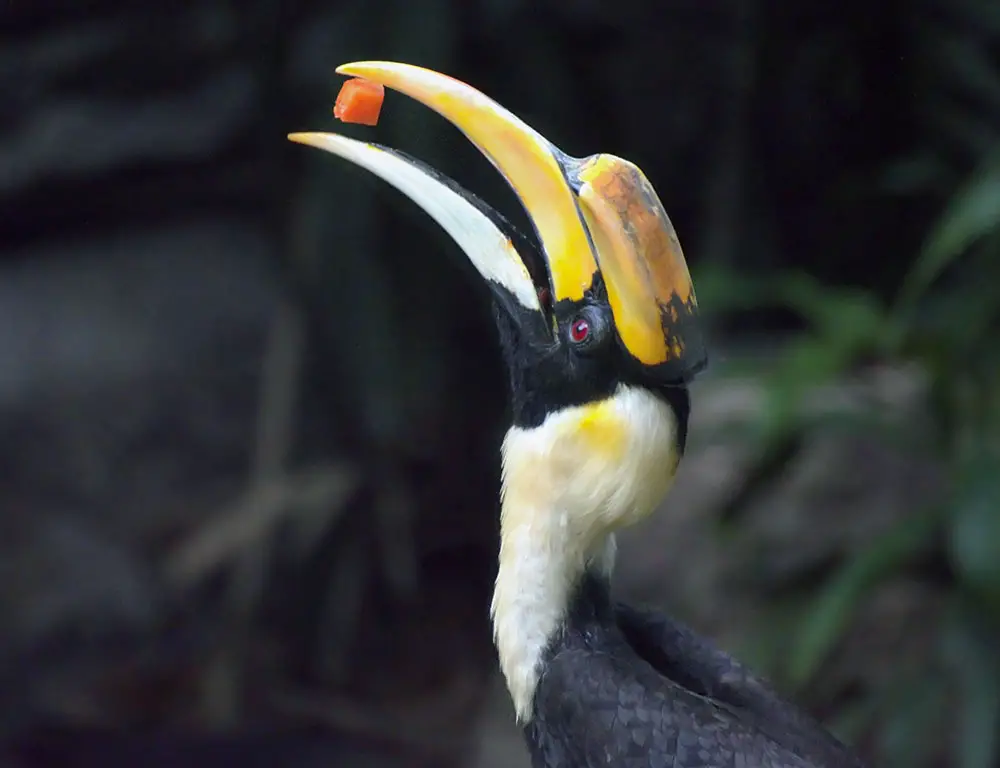
The diet and behavior of the Great Hornbill provide fascinating insights into the lifestyle of these remarkable birds:
Diet
- Frugivorous Preference: Great Hornbills are primarily frugivorous, meaning they mainly consume fruits. Fruit makes up about 60% of their diet.
- Varied Diet: While fruits are their mainstay, Great Hornbills also include animals, constituting around 40% of their food intake. This can consist of small mammals, birds, or reptiles.
Behavior
- Social Nature: Great Hornbills are social birds often found living in small groups. They exhibit playful behavior and communicate vocally with loud calls that resonate through the forest canopy.
- Breeding Behavior: During breeding season, the male Great Hornbill courts the female by bringing her food gifts. The female seals herself inside a tree hole to lay eggs and cares for them until they hatch.
- Defensive Behavior: Despite their social nature, Great Hornbills can be aggressive when threatened. They use their large and powerful bill to defend themselves and their territories.
Conservation Status of the Great Hornbill
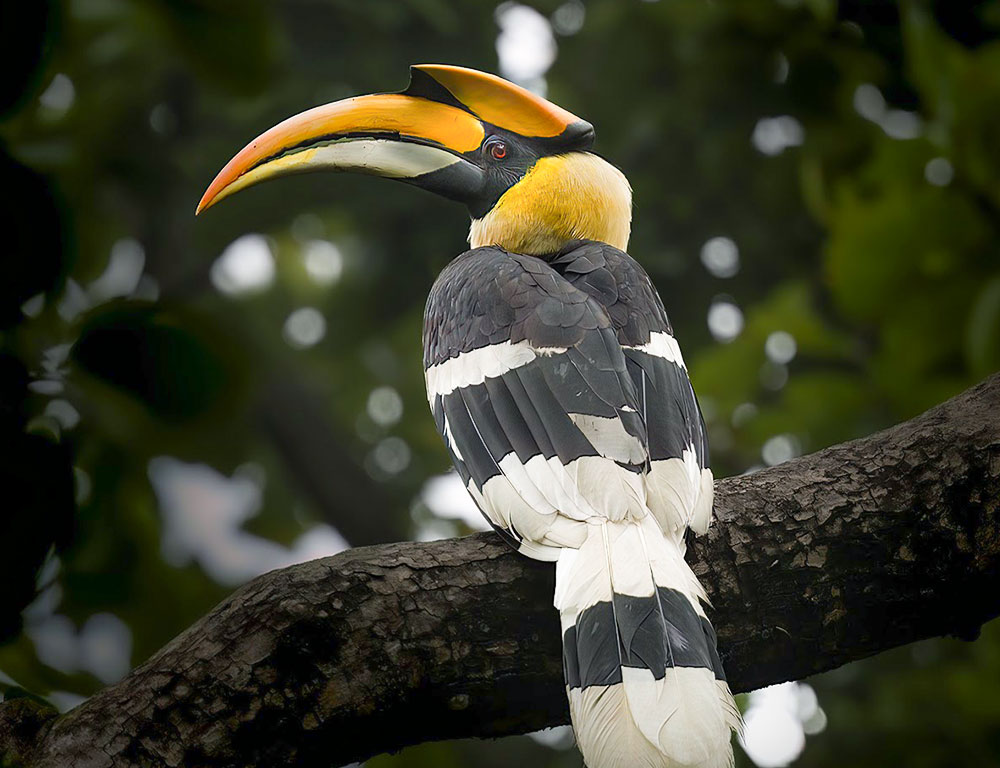
The conservation status of the Great Hornbill indeed presents a concerning situation, with the species classified as ‘Vulnerable’ by the International Union for Conservation of Nature (IUCN). This designation indicates a high risk of becoming endangered unless significant conservation actions are taken.
Several factors contribute to the challenges facing Great Hornbill populations:
Habitat Loss
Human activities such as deforestation for agriculture and urbanization result in the loss of the forests that are vital habitats for Great Hornbills. Without suitable habitat, these birds struggle to find food and nesting sites.
Human-Wildlife Conflict
Encroachment into forested areas brings humans closer to wildlife, leading to conflicts. Due to these interactions, great Hornbills may face disturbance, displacement, or even direct harm.
Hunting and Poaching
Great Hornbills are hunted for various purposes, including their meat and casques, prized as trophy items or used in traditional medicine. This illegal trade further threatens their populations.
Despite these challenges, there are ongoing conservation efforts aimed at protecting Great Hornbills and their habitats:
Habitat Protection
Governments, non-governmental organizations (NGOs), and local communities collaborate to establish and manage protected areas to safeguard the forests where Great Hornbills reside.
Legal Protections
Many countries have enacted laws and regulations prohibiting hunting, trading, and other forms of exploitation of Great Hornbills. Enforcement of these laws is crucial to deter illegal activities.
Breeding Programs
Captive breeding programs in zoos and wildlife parks aim to breed Great Hornbills in controlled environments to supplement wild populations and ensure genetic diversity.
Conclusion
The Great Hornbill, with its vibrant colors, distinctive features, and monogamous nature, captivates the imagination.
Found primarily in Southeast Asia and the Indian subcontinent, these birds boast an impressive lifespan of 35 to 50 years.
Their frugivorous diet, supplemented occasionally by small mammals or reptiles, reflects their adaptation to native habitats.
However, habitat loss, mainly due to deforestation, threatens their survival. Conservation efforts are crucial to safeguarding these majestic beings and preserving biodiversity.
By sharing knowledge and fostering interest in wildlife conservation, we can work towards a future where the Great Hornbill thrives in its natural environment, reminding us of nature’s beauty and importance.